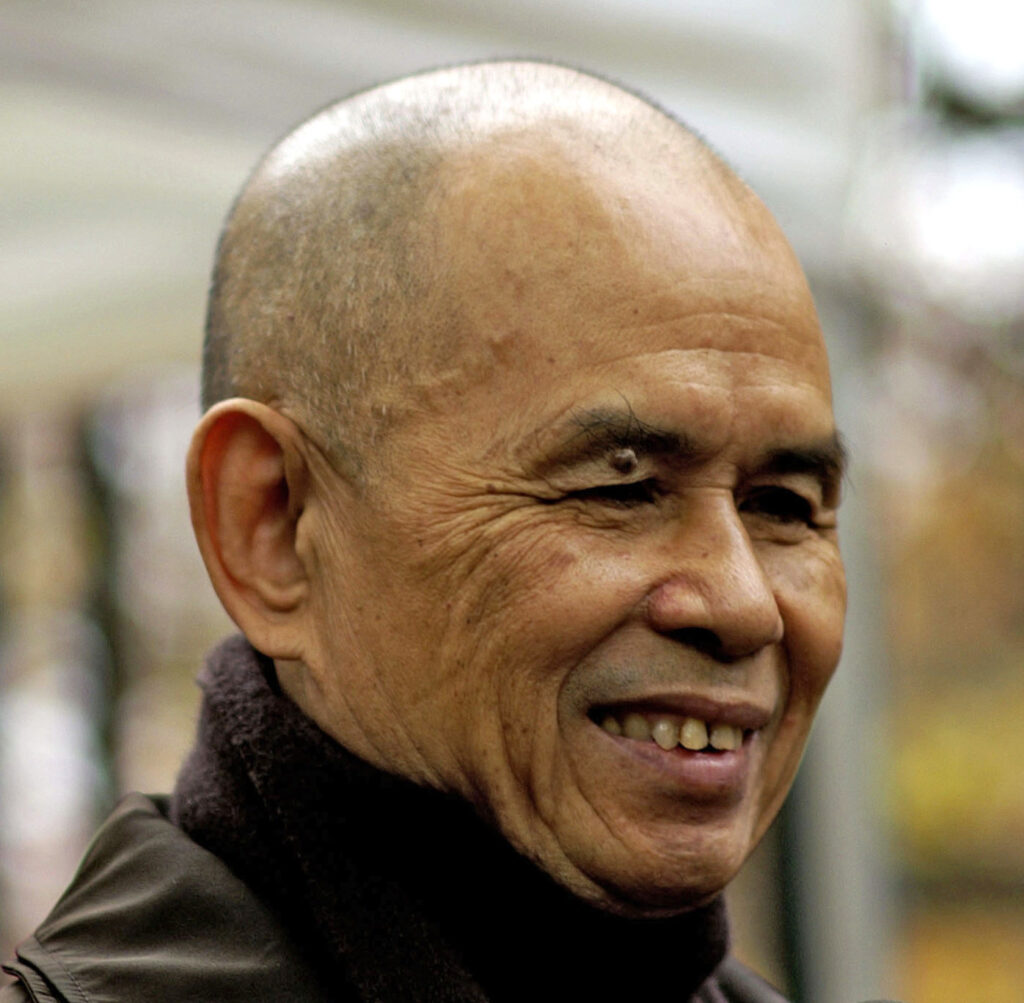
Thich Nhat Hanh, a renowned Vietnamese Buddhist monk died on January 24, 2022. His organization, Plum Village, describes him as “a spiritual leader, poet and peace activist”. He taught about mindfulness – being in the present moment or living in the now. He also worked to advance global peace.
Thich Nhat Hahn was also a prolific writer and dedicated teacher. He has published over 100 books in English and created a series of trainings on developing various aspects of mindfulness. Videos of his workshops on mindful breathing and how to address worrying have millions of views on YouTube. His explanations are clear, and his directions are easy to follow.
Mindfulness dates back about 2500 years but has become increasingly popular in Western cultures. Some say our quest for mindfulness is a result of the ever-increasing stress and anxiety caused by living in a digital world.
Even those who are unfamiliar Thich Nhat Hahn’s teachings are likely to have some knowledge of mindfulness. Countless books have been written on the subject. While many are practical self-help books like Eckhard Tolle’s best seller The Power of Now. fictional works like Paulo Coelho’s The Alchemist offer readers several lessons on mindfulness. Other books offer customized approaches for developing mindfulness based on profession or gender. Resources to develop mindfulness also include mindfulness specialists who provide one-on-one coaching on how to “be in the now”.
While interest in mindfulness is widespread, achieving it is easier said than done. A few common challenges include difficulty telling your mind “not to think” and willingness to engage in a continuous process and make an ongoing effort.
Master of Mindfulness
Thich Nhat Hahn was considered a master of mindfulness and founded several communities based on its principles.
How was he able to do this?
There’s no way to know with certainty. However, it seems that he lived his life in a way that created ongoing opportunities for him to become increasingly mindful. Throughout his life, he spoke out against social injustice and violations of human rights. He also promoted the concept of inter-are.
Through his life experiences, Thich Nhat Hanh achieved an understanding that happiness and suffering go together. In 1966, Thich Nhat Hanh traveled to the United States and Europe to call for an end to the Vietnam war. As a result of his trip, both North and South Vietnam exiled him. He described this experience as being a cell separated from his body, a bee taken out of the beehive. He said “If you have not suffered, you have no chance to experience real happiness”. In acknowledging his own suffering, he was able to understand happiness as a state of being at peace even while suffering.
It seems that Thich Nhat Hanh’s suffering also enabled him to be compassionate. He believed the suffering of one person affects all people. Thich Nhat Hanh’s life exemplifies the virtuous cycle that results from being in the moment: one becomes aware of injustice, one speaks out, one suffers, one develops compassion, and one finds peace.
His example of mindfulness challenges us to be aware of what’s going on around us and make conscious choices about how we use each moment to impact the world.
Engaged Buddhism
Thich Nhat Hanh espoused the notion of engaged Buddhism, which logically flows from his understanding of mindfulness. Engaged Buddhism seeks to apply Buddhist wisdom and insights to real-world situations of social, political, environmental, and economic suffering and injustice. Taking action to alleviate conditions of social injustice, violence and oppression is a pathway to enlightenment or nirvana.
There are countless examples of Thich Nhat Hanh’s practice of engaged Buddhism.
- In 1968, he met with Dr. Martin Luther King and developed a strategy for creating a community movement based on peace and nonviolence. Thich Nhat Hanh’s ability to be in the moment allowed him to be aware of King and his efforts to address social and racial injustice and inequality in America. Because Thich Nhat Hahn understood that human beings are interconnected, he voluntarily joined King and supported his cause.
- In 1984, Thich Nhat Hahn’s father passed away but, because of his status as an exile, he could not return to Vietnam for the funeral. The loss of a parent is accompanied by strong negative emotions such as sadness, frustration, confusion among others. For Thick Nhat Hahn, the grieving process must have been even more difficult because he could not be with family and participate in the traditional rituals used to bury the dead. His experience of the loss of his father could be what led him to hold ceremonies for those who had died in the Vietnam War when he was finally able to return to Vietnam in 2007. The suffering he endured from not being able to bury his father led him to provide experiences of comfort and healing to others who had lost loved ones.
- In the early 2000s, Thich Nhat Hahn led retreats for American war veterans, an effort that demonstrates his ability to accept and move past the fact that American soldiers had been sent to kill his countrymen decades earlier.
- Beginning in 2003, Thich Nhat Hahn held multiple retreats for Israelis and Palestinians. These retreats illustrate how, having made peace with the suffering he experienced as a result of the Vietnam War, he understood and sought to alleviate the unrelenting human suffering taking place in the Middle East. At the time he said, “You cannot be an instrument of peace if you have no peace within yourself ”.
Thich Nhat Hahn’s engaged Buddhism was not limited to his ability to understand humanity. It extended to the environment. In 2013, he spoke of the power of recognizing the interconnectedness of all life, including nature. He believed that our universal interconnectedness inspires love and that mindfulness is key to preventing eco-anxiety that leads people to ignore the dangers of climate change. Some cases of eco-anxiety reach clinical levels.
Death That Brings New Possibilities
The passing of Thich Nhat Hahn refocused attention on the man and his work. Thus, even in death, he created new possibilities for individuals’ spiritual advancement.
Retracing Thich Nhat Hahn’s steps through history evidences a remarkable alignment between his words and deeds. He said: ”You have to have the courage to speak out against social injustice, the violation of human rights.” And that is exactly what he did.
In our quest for mindfulness can include asking ourselves, “Do I choose to recognize the suffering in the world, and am I willing to take action?”. Mindfulness requires more than knowing the Eightfold Path. It requires that we live it.
That’s not to say that our efforts to become more mindful should not include reading books and working with experts. They should. But Thich Nhat Hahn’s brief time on earth makes clear that mindful living is about the personal choices we make each day. Being in the “now” means intentionally focusing our attention on what’s happening in the world and choosing to not ignore how it affects humanity. It means speaking out against injustice and taking action to improve the conditions that affect other human beings.
If we can consciously embrace our own suffering, we will be better able to sympathize and empathize with the suffering of others.
In doing so, we can make our peace with the imperfect and impermanent world in which we live.
